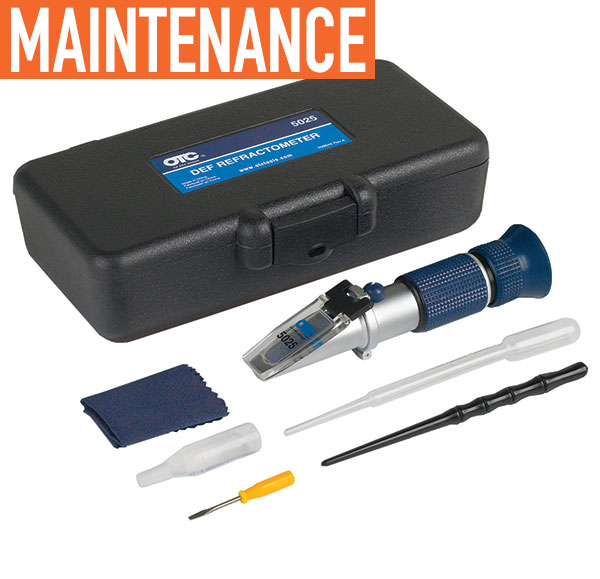The Diesel Exhaust Fluid (DEF) used in Selective Catalytic Reduction (SCR) emissions systems might seem like a simple thing to manage, much like putting fuel in your vehicle. However, there are some important considerations to be aware of when it comes to DEF, particularly as the weather turns colder throughout most of the country.
SCR treats exhaust gas downstream from the engine and is designed to reduce the amount of nitrous oxide (NOx) in emissions. The system uses a liquid-reductant, which is injected into a catalyst in the exhaust stream of a diesel engine. The liquid-reductant utilized in the process is urea, which is commonly referred to as DEF. The chemical reaction caused by the introduction of DEF converts nitrogen oxides into nitrogen, water, and small amounts of carbon dioxide (CO2) which are passed through the vehicle tailpipe.
SCR systems can provide fuel economy savings and fully optimize the engine. Properly caring for DEF can translate to significant savings. SCR has proven to be helpful in meeting US EPA 2010 diesel engine emission standards for heavy-duty vehicles and Tier 4 emissions standards for engines used in off-road equipment.
DEF SERVICE
For commercial use, one to three gallons of DEF is needed for every 100 gallons of fuel—roughly one percent to three percent of the amount of fuel. When vehicles come in for service, they often need to have the DEF topped off. DEF is nontoxic and is not harmful when handled properly; however, it is highly corrosive to copper, brass, and other materials. For this reason, special pumping equipment is needed to dispense DEF.
OTC offers a number of products and kits to properly handle and dispense DEF. Basic tote and drum kits provide an electric AC pump, inlet hose, discharge hose, and a manual nozzle. Deluxe kits include a dispenser coupler valve, which helps maintain DEF purity and the proper concentration. Additional products to assist in DEF maintenance include a Digital Turbine Meter, which measures in liters, quarts, pints, and gallons, and has a flow range of 1.3 to 32 gallons per minute, as well as a pneumatic DEF pump with telescopic suction tube, and a pneumatic double diaphragm DEF pump. Additionally, a hand operated DEF pump and an auto shut-off DEF nozzle are available.
The variety of pumps offered by OTC meets the needs of big and small shops and fleets, as well as drivers who may need to top off their own DEF. The pumps allow for easy refill and help avoid spills, while also helping to maintain the appropriate DEF levels in machinery.
PROPER HANDLING, TESTING
As DEF contains a 67.5-percent concentration of water, some evaporation is likely to occur, so keeping DEF properly sealed is vital. OTC offers two refractometers specifically designed to test DEF quality. OTC offers two products to measure DEF concentration, the 5025 DEF Refractometer, which is a portable, precision optical instrument, and the OTC 3095 Electronic Refractometer.
When purchasing DEF, make sure it displays the certification of the American Petroleum Institute, which assures proper concentration of urea. The ideal concentration for DEF is 32.5 percent, and provides the lowest possible freeze point. DEF will start to freeze at 12 degrees Fahrenheit (-11 degrees Celsius).

Featured Image: OTC 5025
Above: OTC 3095
If DEF does freeze with the proper concentration of 32.5 percent urea and the rest water, both ingredients will freeze at the same rate, so when it thaws, it will not become diluted or over-concentrated. Freezing and thawing will not harm DEF. Like most liquids that freeze, there is expansion to consider when filling the DEF tank in colder weather.
Do not add any aftermarket additives to prevent freezing, as the 32.5 percent solution in DEF is extremely specific to reducing NOx. Making changes to DEF can damage the SCR components.
DEF STORAGE
DEF should be kept in a cool, dry location and sealed tightly. Shelf life for DEF is approximately two years with ideal conditions, which includes storage at a consistent temperature of about 75 degrees Fahrenheit. A dispenser coupler valve like the OTC 4333 will help maintain DEF purity and the proper concentration by covering 55-gallon barrels or 275/330-gallon totes while allowing pumping from the dispensers. OTC pumps and kits can help ensure that your DEF is properly maintained while being stored and transferred.
VEHICLE DEF MAINTENANCE
Finally, make sure to keep your DEF filled for on-highway use. If the vehicle runs low on DEF, indicators on the dash will alert the driver that more is needed. If the DEF gets too low, the vehicle power will be restricted. Normal power will be resumed once the DEF tank is refilled.
FOR MORE INFORMATION:
Find out more about Bosch’s products and services, visit www.bosch.com.
_______________________________________________________________________
MODERN WORKTRUCK SOLUTIONS: DECEMBER 2016 ISSUE
Did you enjoy this article?
Subscribe to the FREE Digital Edition of Modern WorkTruck Solutions magazine.
![]()




